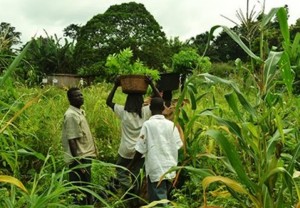 In 2014, GH¢170.62 million in oil revenues was designated for modernisation of agriculture and 70 per cent of that was spent on construction of coastal defences for fishing communities and construction and rehabilitation of irrigation dams.
In 2014, GH¢170.62 million in oil revenues was designated for modernisation of agriculture and 70 per cent of that was spent on construction of coastal defences for fishing communities and construction and rehabilitation of irrigation dams.
The amount allocated to modernisation of agriculture in 2014, representing about 31 per cent of the Annual Budget Funding Amount (ABFA) (the amount of oil revenue that goes into the budget), was an astronomical increase of 1,155 per cent from 2013 and nearly twice the amounts allocated for agriculture modernisation, from 2011 to 2013 cumulatively which is GH¢99.22 million.
According to the 2014 report of the Public Interest and Accountability Committee (PIAC), the committee mandated by law to ensure prudent utilization of oil revenues by government, GH¢118.38 million of the allocated amount went into construction of sea defence walls in four fishing communities.
Interestingly, PIAC which is underfunded by government, says the projects were not mentioned among the projects and programmes earmarked for implementation in the fisheries and aquaculture sector in 2014.
Only about GH¢4.317 million went into payment for the 2013 fertilizer subsidy programme.
The Vice Chairman of PIAC, Kwame Jantuah, was in wonder on the rationale behind the spending of the agriculture modernisation funds and said the Ghanaian citizenry have failed to use the mandatory disclosures on petroleum revenues, to hold government to account and to ensure value maximisation on petroleum projects.
Nine irrigation dams were rehabilitated and one new one was constructed in the Upper East Region.
Four irrigation dams were rehabilitated in the Upper West Region and one was also rehabilitated in the Central Region.
One irrigation dam was rehabilitated at Dawa in the Greater Accra Region.
A whopping GH¢119.15 million was spent on fisheries and aquaculture including GH¢764,770 in works at the Anomabu Fisheries College in the Central Region, interim valuation for a two-storey lab block and construction of a fisheries hostel block, and four coastal defence projects: Ngyiresia Sea Defence Project, Ajoa Coastal Protection Project, Samono Sea Defence Project and the Atorkor/Dzita/Anyanui Sea Defence project.
This nature of spending in agriculture modernisation, comes at a time when growth of Ghana’s services sector has outstripped agriculture and when agricultural productivity in Africa, is reported to still be lower than other world regions.
According to one economist of the World Bank, the average agricultural productivity across Africa, is only about 1.4 tonnes per hectare while some developing countries in Asia such as China and Vietnam, had moderate yields of about 2 to 3 tonnes per hectare even in the 1980s.
Data from the World Bank also shows that employment by agriculture, as a percentage of Ghana’s total employment, fell from 53.4 per cent in 2005, to 43.2 per cent in 2012.
By Emmanuel Odonkor
